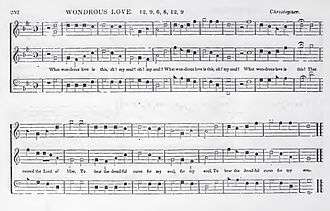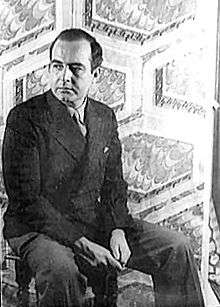What Wondrous Love Is This

"What Wondrous Love Is This" (often just referred to as "Wondrous Love") is a Christian folk hymn, sometimes described as a "white spiritual", from the American South.[1] Its text was first published in 1811, during the Second Great Awakening, and its melody derived from a popular English ballad. Today it is a widely known hymn included in hymnals of many Christian denominations.[2]
Origins

The hymn's lyrics were first published in Lynchburg, Virginia in the c. 1811 camp meeting songbook A General Selection of the Newest and Most Admired Hymns and Spiritual Songs Now in Use.[3] The lyrics may also have been printed, in a slightly different form, in the 1811 book Hymns and Spiritual Songs, Original and Selected published in Lexington, Kentucky.[4] (It was included in the third edition of this text published in 1818, but all copies of the first edition have been lost.[4]) In most early printings, the hymn's text was attributed to an anonymous author, though the 1848 hymnal The Hesperian Harp attributes the text to a Methodist pastor from Oxford, Georgia named Alexander Means.[5]
Most sources attribute the hymn's melody to the 1701 English song "The Ballad of Captain Kidd", which describes the exploits of pirate William Kidd (misnamed "Robert" in American versions of the ballad).[6][note 1] The melody itself predates the Kidd usage, however, possibly by more than a century.[8] (In addition, at least a dozen popular songs were set to the same melody after 1701.[9]) In the early 1800s, when the lyrics to "What Wondrous Love Is This" were first published, hymnals typically lacked any musical notation.[10] Camp meeting attendees during the Second Great Awakening would sing the hymns printed in these hymnals to a variety of popular melodies, including "The Ballad of Captain Kidd", which was well known at the time; this is likely how the text and melody came to be paired.[11] The text and melody were first published together in The Southern Harmony, a book of shape note hymns compiled by William Walker. Sources disagree, however, about which edition of The Southern Harmony first contained the hymn, giving contradictory dates of 1835,[5] 1840,[12] and 1843.[13] The three-part harmony printed in The Southern Harmony was arranged by James Christopher of Spartanburg, South Carolina.[4] In a later printing of the hymn, William Walker noted that it was a "very popular old Southern tune".[14]

Later use
In 1952, American composer and musicologist Charles F. Bryan included "What Wondrous Love Is This" in his folk opera Singin' Billy.[15] In 1958, American composer Samuel Barber composed Wondrous Love: Variations on a Shape Note Hymn (Op. 34), a work for organ, for Christ Episcopal Church in Grosse Pointe, Michigan; the church's organist, an associate of Barber's, had requested a piece for the dedication ceremony of the church's new organ.[16] The piece begins with a statement that closely follows the traditional hymn; four variations follow, of which the last is the "longest and most expressive".[16]
In 1966, the United Methodist Book of Hymns became the first standard hymnal to incorporate What Wondrous Love Is This.[5] What Wondrous Love Is This is now a widely known hymn and is included in many major hymnals, including the Baptist Hymnal, Book of Praise (Presbyterian), Chalice Hymnal (Christian Church (Disciples of Christ)), Common Praise (Anglican), The Hymnal 1982 (Episcopalian), Lutheran Book of Worship, New Century Hymnal (United Church of Christ), Presbyterian Hymnal, Voices United (United Church of Canada), The Worshipping Church (interdenominational), Worship (Roman Catholic), and Singing the Living Tradition (Unitarian Universalism), and A New Hymnal for Colleges and Schools (interdenominational).[2]
Music and lyrics
 |
What Wondrous Love Is This
What Wondrous Love Is This, as performed by Joshua Messick. There is a twelve-second introduction before the first verse of the hymn begins. |
| Problems playing this file? See media help. | |
The hymn is sung in Dorian mode, giving it a haunting quality.[17] Though The Southern Harmony and many later hymnals incorrectly notated the song in Aeolian mode (natural minor),[18] even congregations singing from these hymnals generally sang in Dorian mode by spontaneously raising the sixth note a half step wherever it appeared.[19] Twentieth-century hymnals generally present the hymn in Dorian mode, or sometimes in Aeolian mode but with a raised sixth.[18] The hymn has an unusual meter of 6-6-6-3-6-6-6-6-6-3.[20]
The song's lyrics express awe at the love of God and are reminiscent of the text of John 3:16.[21] The following lyrics are those printed in the 1811 hymnal A General Selection of the Newest and Most Admired Hymns and Spiritual Songs Now in Use;[22] a number of variations exist, but most are descended from this version.[23]
|
1. |
3. |
5. |
Notes
References
Footnotes
- ↑ Joyner, p. 22; Routley, p. 183.
- 1 2 Glover, p. 826; Routley (2005a), pp. x–xi, 183.
- ↑ Glover, p. 829; McKim, p. 78.
- 1 2 3 Glover, p. 829.
- 1 2 3 Routley (2005a), p. 183.
- ↑ Bonner, p. 378; Cobb, p. 30; Crawford, p. 167; Jackson (1951); Nicholls, p. 153; Ogasapian, p. 107.
- ↑ McKim, p. 78.; Music, p. xxiv; Ogasapian, p. 107.
- ↑ Cobb, pp. 30–31; Crawford, p. 167; Jackson (1951); Jackson (1968), p. vii; Lomax, p. 8.
- ↑ Cobb, pp. 30–31; Jackson (1951); Lomax, p. 8.
- ↑ Bonner, p. 377.
- ↑ Bonner, pp. 375–78.
- ↑ Music & Richardson, p. 293.
- ↑ McKim, p. 78.
- ↑ Eskew and McElrath, p. 164.
- ↑ Anderson-Green, p. 162.
- 1 2 Heyman, pp. 400–401.
- ↑ Music, p. xiv; Nelson, p. 6; Westermeyer, p. 280.
- 1 2 Music, p. xiv.
- ↑ Cobb, p. 33; Christ-Janer et al., p. 15.
- ↑ Music, p. xxiv.
- ↑ White et al., p. 159.
- ↑ Glover, pp. 826–27; Routley (2005b), p. 340.
- ↑ Glover, pp. 826–27.
Bibliography
- Anderson-Green, Paula Hathaway (2002). A Hot-Bed of Old-Time Musicians: Traditional Music in the Upper New River Valley-Whitetop Region. University of Tennessee Press. ISBN 978-1-57233-181-5.
- Bonner, Willard Hallam (January 1944). "The Ballad of Captain Kidd". American Literature. 15 (4): 362–380. ISSN 0002-9831. JSTOR 2920762.
- Christ-Janer, Albert; et al. (1980). American Hymns Old and New: The Hymns. Columbia University Press. ISBN 978-0-231-03458-6.
- Cobb, Buell E. Jr. (2004). The Sacred Harp: A Tradition and Its Music. University of Georgia Press. ISBN 978-0-8203-2371-8.
- Crawford, Richard (2001). America's Musical Life: A History. W. W. Norton & Company. ISBN 978-0-393-04810-0.
- Eskew, Harry; Hugh T. McElrath (1980). Sing With Understanding: An Introduction to Christian Hymnology. Broadman Press. ISBN 978-0-8054-6809-0.
- Glover, Raymond F., ed. (1990). The Hymnal 1982 Companion. 4. Church Publishing (Episcopal Church). ISBN 978-0-89869-686-8.
- The Harvard University Hymn Book. Harvard University Press. 2007. ISBN 978-0-674-02696-4.
- Heyman, Barbara B. (1992). Samuel Barber. Oxford University Press. ISBN 978-0-19-535810-0.
- Jackson, George Pullen (1951). "The 400-Year Journey of the 'Captain Kidd' Song Family--Notably Its Religious Branch". Southern Folklore Quarterly. 15: 239–248. ISSN 0038-4127.
- Jackson, George Pullen (1968). "The Story of the Sacred Harp 1884–1944". In White, Benjamin Franklin; E.J. King (1968). The Sacred Harp. Broadman Press. OCLC 981788.
- Joyner, Charles (1999). Shared Traditions: Southern History and Folk Culture. University of Illinois Press. ISBN 978-0-252-06772-3.
- Lomax, Alan (1960). The Folk Songs of North America, in the English language. Doubleday. OCLC 190825.
- McKim, LindaJo H. (1993). The Presbyterian Hymnal Companion. Westminster John Knox Press. ISBN 978-0-664-25180-2.
- Music, David (2005). A Selection of Shape-Note Folk Hymns: From Southern United States Tune Books, 1816–61. A-R Editions. ISBN 978-0-89579-575-5.
- Music, David; Paul Akers Richardson (2008). "I Will Sing the Wondrous Story": A History of Baptist Hymnody in North America. Mercer University Press. ISBN 978-0-86554-948-7.
- Nelson, Mark Kailana (2011). Favorite Old-Time American Songs for Dulcimer. Mel Bay Publications. ISBN 978-1-60974-555-4.
- Nicholls, David (1998). The Cambridge History of American Music. Cambridge University Press. ISBN 978-0-521-45429-2.
- Ogasapian, John (2007). Church Music in America: 1620–2000. Mercer University Press. ISBN 978-0-88146-026-1.
- Routley, Erik (2005a). An English Speaking Hymnal Guide. GIA Publications. ISBN 978-1-57999-354-2.
- Routley, Erik (2005b). Panorama of Christian Hymnody. GIA Publications. ISBN 978-1-57999-352-8.
- Westermeyer, Paul (2005). Let the People Sing: Hymn Tunes in Perspective. GIA Publications. ISBN 978-1-57999-353-5.
- White, Benjamin Franklin; et al. (1911). Original Sacred Harp. OCLC 11394316.
External links
- YouTube video of Canto Deo choir singing "What Wondrous Love Is This"